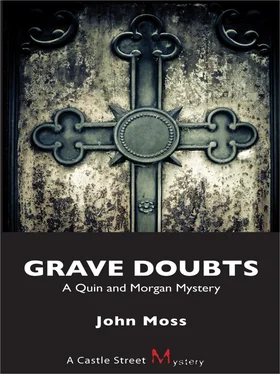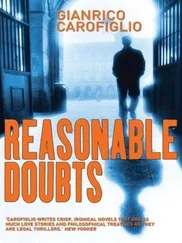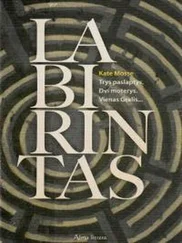John Moss - Grave doubts
Здесь есть возможность читать онлайн «John Moss - Grave doubts» весь текст электронной книги совершенно бесплатно (целиком полную версию без сокращений). В некоторых случаях можно слушать аудио, скачать через торрент в формате fb2 и присутствует краткое содержание. Жанр: Криминальный детектив, на английском языке. Описание произведения, (предисловие) а так же отзывы посетителей доступны на портале библиотеки ЛибКат.
- Название:Grave doubts
- Автор:
- Жанр:
- Год:неизвестен
- ISBN:нет данных
- Рейтинг книги:4 / 5. Голосов: 1
-
Избранное:Добавить в избранное
- Отзывы:
-
Ваша оценка:
- 80
- 1
- 2
- 3
- 4
- 5
Grave doubts: краткое содержание, описание и аннотация
Предлагаем к чтению аннотацию, описание, краткое содержание или предисловие (зависит от того, что написал сам автор книги «Grave doubts»). Если вы не нашли необходимую информацию о книге — напишите в комментариях, мы постараемся отыскать её.
Grave doubts — читать онлайн бесплатно полную книгу (весь текст) целиком
Ниже представлен текст книги, разбитый по страницам. Система сохранения места последней прочитанной страницы, позволяет с удобством читать онлайн бесплатно книгу «Grave doubts», без необходимости каждый раз заново искать на чём Вы остановились. Поставьте закладку, и сможете в любой момент перейти на страницу, на которой закончили чтение.
Интервал:
Закладка:
“One nun, the most profoundly affected, kneeled beside the young woman and took her hands, palms upward. She began to speak, and it was in a voice altogether more resonant than her own. She spoke in the first person, but the words were those of Sister Marie Celeste: ‘The Virgin Mother appeared to me, and told me of many things so wonderful I cannot express them. She asked me to share with her the sorrowful burden of our Lord’s crucifixion and the glory of His resurrection, our Son’s blessing for all the world.’ One of the priests was incensed. ‘This is blasphemy,’ he said. And Sister Marie Celeste smiled, and through the nun holding her hands, she said, ‘Our Heavenly Mother forgives her priest his innocence.’
“The priest who had not spoken was so taken aback by the inspired authority of the voice that he dropped to his knees in submission, and was joined almost immediately by the other. The remaining two nuns, not to be outdone, prostrated themselves fully on the Persian carpet. Only the young nun holding the hands of Sister Mary Celeste with the stigmata exposed remained still. Again, the voice spoke: ‘It is not by my words or my deeds but my very life that you shall be redeemed.’”
Morgan was uncertain about how much of Pope’s story was artistic licence. The question of authenticity never crossed Miranda’s mind, although, like her partner, she did not consider herself a person of faith, and certainly not a believer in visions — at least, not those of the Virgin Mary.
Pope had stopped speaking, gathering his resources. They continued in their meandering journey inside the church. The vast interior space seemed smaller, more intimate.
“Someone wrote this down, then?” Morgan inquired.
“The youngest nun did. She lived until the 1950s. She insisted in later years that when she was the voice of Sister Marie Celeste, who in turn proclaimed herself the voice of the Virgin, she was possessed — ”
“By the Devil?” exclaimed Miranda.
“By God. She went to the grave a believer, despite excommunication.”
“She was excommunicated?” exclaimed Morgan. “For what?”
“For believing. The word spread of Mary’s appearance. It happened in April. By September there were crowds each Sunday, and even during the week, if the weather was bad, when the farmers could get away from their fields and their herds. The bishop, the archbishop, the cardinal, all sent investigators. Even the Vatican was aware of Sister Marie Celeste. Naturally, the clergy was cynical. Miracles are much better received out of history than as immanent experience. They demanded further miracles. The vision was not enough.
“All that summer Sister Marie Celeste was a holy terror. Through the youngest nun she made pronouncements on spiritual matters, urged reform in the Church, commented on local politics, on matters of weather for the benefit of farmers, offered advice on affairs of the heart and marital discord, and in direct contravention to dogma and doctrine she declared female submission anathema to the Mother of God.”
Miranda, who had grown up in the Anglican branch of the wholly Catholic church, gasped in delight. Morgan, whose parents were lapsed Presbyterian before him — which, he felt, placed him on a theological spectrum closer to atheist than agnostic — thought the sister’s radical feminism eminently sensible.
“The two priests were very well pleased to see their collection plates brimming,” Alexander Pope continued, “but they resented their servant’s success. They had to get a new housekeeper, for one thing. The nun and Sister Marie Celeste took over a wing of the rectory as their own quarters. Sister Marie Celeste’s stigmata healed over. Her companion spoke for her in a normal voice, in arranging quotidian details of their lives, but still, occasionally, the voice of Mary spoke through her when Sister Marie Celeste was inspired or provoked.”
“Why have we heard nothing of this?” asked Miranda.
“Why would you? There are small miracles all over the world every day, and cults of one sort or another are constantly forming and reforming. The Church is a cult of epidemic proportions that subsumes lesser cults for replenishment. Others fade, some virtually explode, some are erased.”
“And this cult of Sister Marie Celeste,” said Morgan, “was erased.”
“Indirectly.”
“You said she died in disgrace, Alexander. What happened?”
“Patience, Miranda. She died. It is as simple as that. In November she died. There was no warning. The doctor could not determine the cause. She expired one night, just over here.” They moved up onto the chancel, a stone platform hardly a step above the rest of the floor.
Miranda felt a tremor run down her spine. “Where?”
“Under these slabs, right here. The priests were afraid to disturb her body any more than necessary. She lay in state in an open casket for three days on a catafalque erected over the spot where she died. Here. People came from miles around to grieve, to pray for her, and many, to pray through her to God. When it was time, her casket was sealed. The floor was laid open, and a crypt was prepared in the solid rock underneath. When the crypt was ready, some weeks later, a solemn ceremony was held, during which her casket was reopened and a strong odour of violets rose from its recesses and washed through this entire building, and her flesh was not corrupt but gleamed in the candlelight and her hands lay in the shallow casket at her sides, the palms turned upwards, and small pools of fresh blood glistened at their centres. The nun who had been her acolyte and companion stood beside her and placed a hand on Sister Marie Celeste’s breast, which appeared to rise and fall from the beating of the nun’s own heart as she spoke for the final time the words of Mary in her own voice, which resounded through the hearts of all who were crowded in this building to listen.”
“What did she say?” asked Miranda, totally enthralled.
“No one knows. Perhaps she was speaking in tongues — each heard in the voice a clear message, but for each it was different. It was not glossalalia, since for everyone present it made sense, yet none could agree on what had been said.”
“Not unlike most conversations,” said Morgan. “The more engaging the utterance, the more likely we hear whatever we want, or need, to hear.”
“Morgan, you’re a cynic,” said Miranda.
“Not at all. I’m on the verge of conversion.”
“What happened next?” asked Miranda, more interested in Pope’s story than her partner’s errant soul. She relished the way Pope’s words seemed to express something deep within that had little to do with faith, and a lot to do with how humans believe.
“The entire church became her shrine,” declared Alexander Pope, turning and facing the gloomy interior of the building, his arms raised — whether in supplication or as a rhetorical gesture, Miranda couldn’t be sure. “In death, her fame took flight. The walls on one side were painted with her story, and on the other were images from the Virgin’s life. And people came — a makeshift town spread like contagion over the surrounding fields. It was like a gold-rush bonanza. Houses made of canvas and boards sprang up helter-skelter along the road allowance. The schoolhouse was turned into a hospital to care for the sick and the dying who came seeking Marie Celeste’s intervention. Some claimed to be cured or relieved, just by pressing the robe of the nun who had been Mary’s voice.”
“Why doesn’t the nun have a name?”
“Oh, she does, but somehow the story seems more authentic if her name is generic. Her name was Sister Mary Joseph. When Sister Marie Celeste died, Sister Mary took to wearing a pale-blue habit, quite unlike the black prescribed by her order. Even after she left the church, she called herself Mary Joseph, and continued to wear a modified blue habit. Her original name was Katherine Morrison, if memory serves. She became known as the Blue Nun.”
Читать дальшеИнтервал:
Закладка:
Похожие книги на «Grave doubts»
Представляем Вашему вниманию похожие книги на «Grave doubts» списком для выбора. Мы отобрали схожую по названию и смыслу литературу в надежде предоставить читателям больше вариантов отыскать новые, интересные, ещё непрочитанные произведения.
Обсуждение, отзывы о книге «Grave doubts» и просто собственные мнения читателей. Оставьте ваши комментарии, напишите, что Вы думаете о произведении, его смысле или главных героях. Укажите что конкретно понравилось, а что нет, и почему Вы так считаете.












